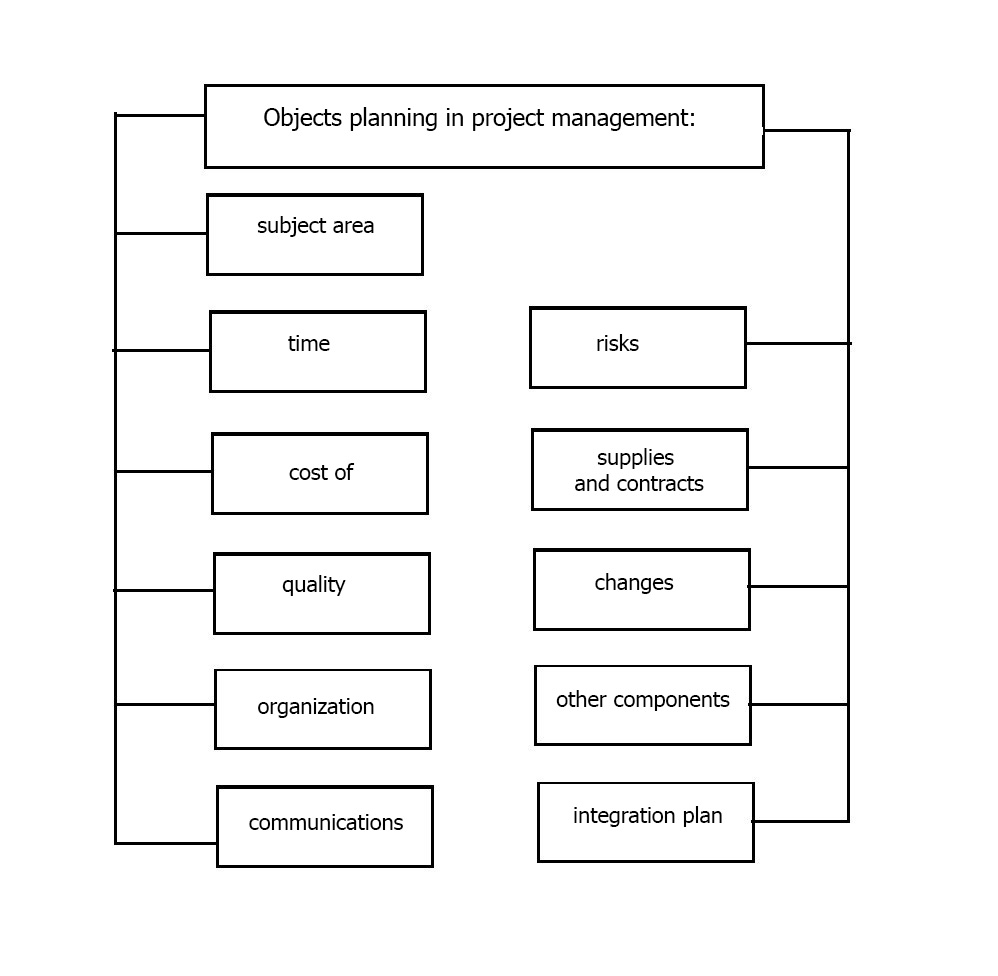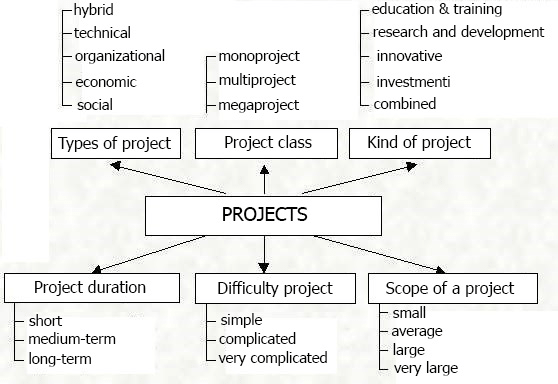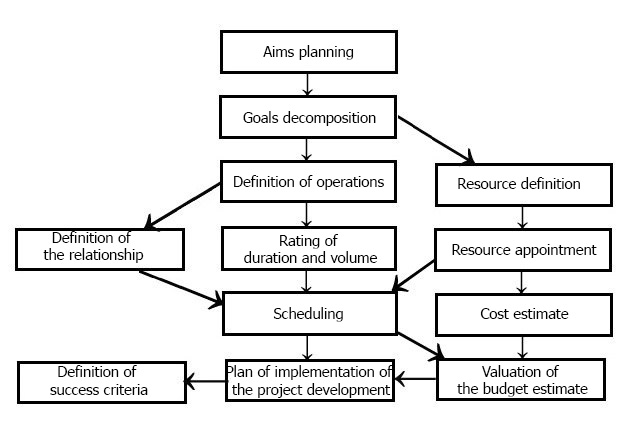Abstract
Contents
- Introduction
- 1. The essence of project management
- 2. Method of project planning
- 3. Approaches to Project Management
- 4. Assessment of project effectiveness
- Conclusion
- References
Introduction
The relevance
In today's rapidly changing environment of the enterprise, project management is one of the five pillars of the modern management of the organization [1]. Properly organized, the project is not only the key to efficient government of the enterprise, but also the proper distribution of available resources, a moderate use of time and budget.
Lack of certain theoretical and practical skills in project management can lead to serious problems such as violation of terms of delivery of the project, the budget excess, decreasing of the project's quality, which ultimately affect the technical backwardness and loss of competitive advantages of the organization, which is especially important for industrial enterprise.
The aims and objectives of the study
The aim of this study is to summarize the theoretical foundations of the project management organization and selection of them to justify the basic feasibility of particular project management systems, which improve the efficiency of industrial enterprises.
To achieve this goal, we need to solve the following tasks:
- To discover the essence of project management;
- To consider the types of projects;
- To examine the methodology of project planning;
- Highlight the key approaches to project management;
- To analyze the methodology to assess the efficiency of the investment project;
- Identified by the basic characteristics of the project improve the efficiency of industrial enterprises work and choose the basic elements of scientific-theoretical substantiation of its feasibility.
The object and subject of study
Object of research – the process of project management organization.
The subject of the research is theoretical aspects and methodological foundations of project management.
Analysis of recent research and publications
Project Management Issues studied by such scientists: J. Harrington, V. A. Rach, G. Gantt, M. Romanov, D. Cleveland, A. Steshin, A. Fayolle, J. Mazur, F. Taylor, A. Ilyin, V. Shapiro, E. Utkin. In the works of these scientists determined the essence of project management, their classification, designed indicators by which the success of the project depends directly.
1. The essence of project management
Until nowadays, the term project
( lat. projectus – thrown forward) experts interpreted this way: it is a drawing, explanatory memorandum and financial calculations, upon which you can build an airplane, construction or factory, or the text that precedes the document – the plan, contract deal.
Project management concept is based on the notion of a project
. Different authors believe, that the term project
may have a different interpretation.
Thus, A. Klotchkov believes that the project – a unique process, consisting of a set of interconnected and controlled work with start and end dates, and aimed to achieve the goal of compliance with the specific requirements, including restrictions on time, cost and resources [2].
E. Utkin gives this definition: project – a single, time-limited targeted event, requiring involvement of specialists of different qualifications and resources [3].
A. Zub says, the project – a set of actions (usually lasting less than three years), consisting of interrelated tasks with clearly defined objectives, planned schedule and budget [4].
In the modern sense, project
is interpreted:
- an activity, measures providing for the implementation of specific actions to achieve proper goals (obtaining certain results); closest meanings of the term –
economic activity
,work (work package)
; - a system of organizational, legal and financial settlement and documents, necessary to perform certain actions or those that describe these actions [5].
Project management – a methodology of organization, planning, management, coordination of manpower, financial and material resources throughout the project cycle, aimed at the effective achievement of its objectives through the application of modern techniques, equipment and control technology to achieve specific project results on the composition of work, cost, time, quality and satisfaction of the participants (figure 1) [6].

Figure 1 – Presentation of project management entity
The main features of the project are [7]:
- Purpose – is the main reason why the project starts. It describes the final outcome of the project. The project is considered completed, when the goal is reached. The purpose of the project must be real, for example, if the goal is to expand the area of the store, it is better to say that the goal is to build a new food hall on the third floor. So that's how we learn that the project is completed, when our goal (setting up a new food hall on the third floor) is reached. The purpose of the project is directly related to the subject of planning in project management (figure 2) [3].
- The budget – it is a total amount of funds required for the project.
- Objectives – some activities (small steps) that make up the project. The more clearly the problem is formulated, the easier it will be to plan the activities and this will lead to a more rapid achievement of the project objectives.
- Resources – the instruments by which we can finish the tasks or the whole project, such as equipment, personnel, etc.
- Time – this is a total time interval for which the task or the entire project is done.

Figure 2 – Objects of planning
In the project management theory, projects are classified in many ways (figure 3) [4].

Figure 3 – Classification of projects
2. Method of project planning
Project planning – is a cyclic process, starting with the most common definition of objectives, moving to a more detailed description of how, when and what work must be performed in order to achieve these goals. As we promote the project from concept to completion, an additional information about conditions that affect the progress of work appears. Application of planning and project management enables team members to describe more clearly the problems and monitor changes of the project more effectively.
The specific structure of the plans used at different levels and stages of project planning, depends on standards and approaches, adopted in the industry and in organizations involved into the project.
There is a logical sequence of steps of the project development plan, which makes the planning cycle (figure 3) [8].

Figure 4 – The stages of project planning
The following methods of project planning [9,10].
- Scheduling Theory (TS) – a section of operations research, in which the mathematical model of scheduling of various targeted actions are built and analyzed, considering the objective function and the various restrictions.
- Gantt Diagramm – is intended to illustrate the stages of the project. Each work specified due to dates, start and end of work, the connection between the works, all the works displayed in the form of strips connected by arrows, these strips show the percentage of the work and the attached resources. Visualization greatly facilitates the work of the project manager.
- Network planning methods are also reflected on graphic, showing the works of the project. Network graph – scheme consists of the apexes connected by arcs. Apex – is a project work (event), the arc – a work sequence.By formulas we can calculate indicators such as: the critical path, the early period of the event, later date of the event, time reserve. Then, specify costed figures on a graph. You can also optimize the network plans there.
- Pert Method – a method of analysis of the time required to perform each of the works. This method allows you to determine the minimum time necessary to complete the project. According to this method it is possible to build network diagrams, such as discussed above, as well as to evaluate the project timeline: optimistic, pessimistic and realistic. All indicators are calculated according to the formulas.
- Heuristic optimization methods. Heuristic methods provide identification, processing and ordering system of regulations, mechanisms and methodological tools to design a new objective and purposeful ways of activity based on the generalization of previous experience and anticipatory reflection of future models in order to solve this problem most effectively.
- Metaheuristic optimization techniques. The most effective and popular heuristic methods include so-called metaheuristics – generalized optimum search strategy in the solution space. Starting their implementation is usually quite simple and allows you to quickly get the result.
3. Approaches to project management
These approaches are [11]:
- systematic approach – allows us to consider the project as a set of related elements – a system that lives in a dynamically changing environment. The environment changes, regardless on the project or under its influence. At this level the important issues of the project are creation and its interaction with the environment.
- project approach – characterized by a clear focus on the goal – creation of a
product of the project
. Project management tools are based on the uniqueness of the project and ensuring the reaching of objectives in the given criteria system. If you select thehierarchy
, as a model for the interaction of these approaches, the project approach is integrated into to the system, and the methodology of the interaction of approaches represented in the form of aone iside the other
. - process approach – it is associated with the need to regulate and unify the action of project managers, lead them to repeating processes with the description of the input and output parameters (resources), as well as a set of activities that transform inputs into outputs. The process approach is tied to a specific domain (construction, information technology, etc.) and allows to formalize the actions of the project manager. The model
one inside the other
process approach is integrated into design. - scenario approach – is associated with the processes of preparation and decision making in project management. Scripts provide a quick transfer of better practices in a variety of project management processes. The scenario approach, thus, is internal to the p.a., and completes the model of
one inside the other
approaches to project management [11].
4. Assessment of project effectiveness
The effectiveness of the project is estimated, in order to determine the potential attractiveness of the project, the feasibility of its applying for potential participants. It shows the acceptability of the project, regardless of the financial capacity of its participants.
This efficiency, in turn, includes [12]:
- social (socio-economic) efficiency of the project. It takes into account the socio-economic consequencies of IP for society, including both the direct costs of the project and the results of the project and external effects – social, environmental and other effects. As the mechanisms we can use the economic and social security assess of the project;
- the commercial viability of the project. It shows the financial implications of its implementation for the member of IP, if he will cover all the necessary project costs and use benefits from all the results.
You can see the main stages of rating the project performance (figure 5) [2]:

Figure 5 – Steps of rating project performance
(animation: 8 frame, 7 cycles of repetition, 35 kilobytes)
In the practice of investment analysis we can use two basic approaches to the determination of the projects effectiveness rating [13]:
- static (simple) model;
- dynamic model (discounting methods).
Static methods do not take into account the time factor and are based on accounting data, which is calculated on the basis of a simple rate of return and payback period. Building discounted criteria for project evaluation is based on the use of the theory of money value over time. In world practice, the most widely used methods for the following dynamic (UNIDO methods) rating of the following indicators:
- net present effect, or Net Present Valve – NPV;
- discounted Profitability Index – DPI;
- discounted Payback Period – DPP;
- internal Rate of Return – IRR;
- modified Internal Rate of Return – MIRR.
The general scheme of the dynamic performance evaluation methods is quite the same and based on the forecast of positive and negative cash flow in the planned period, and comparing the resulting net cash flows, discounted at the appropriate rate, with investment costs [14].
Theoretical and methodological foundations of project management adapted to the specific development project management control systems of increasing the efficiency of the industrial enterprise are discussed above.
Selection of the basic tools of scientific and theoretical substantiation of the expediency of the system is presented under the heading Conclusions
and based on the following factors:
- object of planning in the management of the project;
- sectoral and territorial jurisdiction of the enterprise where the project is implemented;sectoral and territorial jurisdiction of the enterprise where the project is implemented;
- ensuring cost-effective project.
Conclusion
The study deals with the basic terms and concepts of project management, classification of projects, approaches and methods of project management, criteria and procedures for rating the economic efficiency of the project.
With regard to the project management system, improving the efficiency of industrial enterprise established by the following elements of scientific and technical studies and features:
- The project will be implemented under the DPR in the company's coal mining industry – M. I. Kalinin mine SE DCEC.
- Planning Object refers to economic (particularly management) of the enterprise.
- The aim of the project – improving the economic efficiency of production at the M.I. Kalinin mine SE DCEC.
- The development of the management system will be used: Gantt chart, network techniques, system, process approach, UNIDO methods, and methods for rating the social and economic security of the project.
Iist of references
- J. Harrington. Perfection change management / under scientific. adv. V.V. Bragina. - M .: RIA "Standards and quality", 2008. - 192 p.
- Klotchkov A. How to improve and evaluate the effectiveness of projects // Securities market. - 2008. - ¹ 5.
- Utkin E.A. Project-management.- M .: TEIS 2002.
- Zub A.T. Project Management: textbook and practicum for undergraduate academic batchelor / A.T. Zub. - M .: Yurayt Publishing, 2014. - 422 p.
- Kobilyatsky L.S. Project management: Navch. pos³bnik. - K.: AIDP, 2002. - 200 p.
- Mazur I.I., Shapiro V.D., Olderogge N.G. Project Management: Textbook \, ed. Ed. I.I. Mazur - 2nd ed. M .: Omega-L, 2004.- 664 p.
- Krasnyh D.A. Highlights Project Management // Modern scientific research and innovation. 2015. ¹11 [electronic resource]. URL: http://web.snauka.ru/issues/2015/11/59473
- Razdorozhny A.A. Project management in an organization (enterprise): Proc. Benefit. M .: Examination 2006, 89 p.
- Andreev S.A. Methods for effective project planning // Economy and management of innovative technologies. Number 3 2015. [electronic resource]. URL: http://ekonomika.snauka.ru/2015/03/7579
- Razy M.L. Project management. Fundamentals of Project Management / M.L. Razy [et al.] // Tutorial / group of authors; edited by Professor M.L. Razy. - 3rd ed., Revised. And add. - M.: KNORUS, 2011. - 768 p.
- E. resource. Access: http://www.studfiles.ru/preview/5080546/page:25/
- Kovalev V.V. Methods for evaluation of investment projects. - M .: Finance and Statistics, 2005.
- Vasilyeva M.V., Fedorova O.V. Development of the system of financing of investment projects under the public-private partnership in Russia // Economic analysis: theory and practice.- 2011.- ¹ 9.- 86 p.
- . Sitnikov S.E. Methods for evaluating the economic efficiency of innovative projects of the military-industrial complex // Economy and management of innovative technologies. Number 11, 2013. [e. resource]. URL: http://ekonomika.snauka.ru/2013/11/3343
